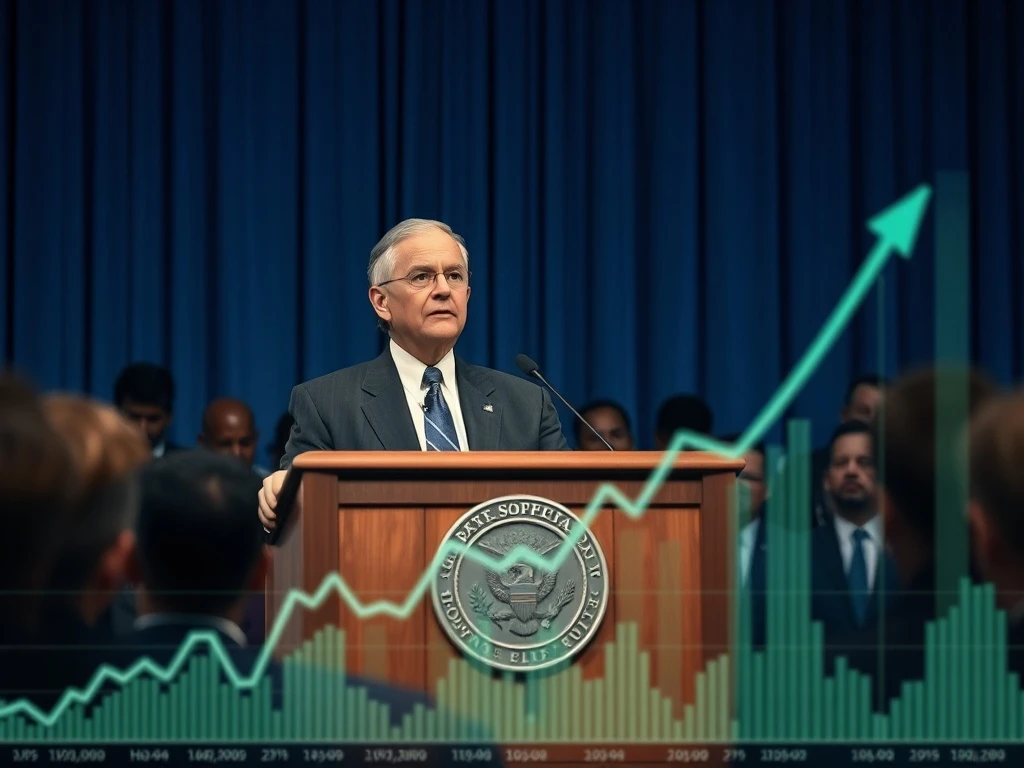The financial world eagerly anticipates Federal Reserve Chair Jerome Powell’s upcoming speech. This address holds significant implications, particularly for the **housing market**. Many analysts believe **Powell’s Speech Housing** impact could provide a much-needed boost. Understanding these potential shifts is crucial for anyone involved in real estate, from potential homeowners to seasoned investors. Therefore, closely monitoring economic signals from the Federal Reserve becomes paramount.
Understanding the Stakes of Powell’s Speech Housing
Jerome Powell’s speeches carry immense weight. As the head of the Federal Reserve, his words often dictate the direction of monetary policy. This policy directly influences interest rates, inflation, and the broader economic environment. Consequently, these factors ripple through various sectors, including the vital housing market. His remarks can signal future changes in interest rates, which directly affect mortgage costs. Therefore, participants across the housing sector pay close attention to every statement.
Historically, Federal Reserve actions have a profound effect on borrowing costs. When the Fed raises its benchmark interest rate, commercial banks typically follow suit. This makes mortgages more expensive, thus reducing affordability for many buyers. Conversely, a more accommodative stance, perhaps signaled by Powell, could lead to lower rates. Lower rates make homeownership more accessible, potentially stimulating demand. Ultimately, the market reacts swiftly to these signals.
Key areas of focus for the upcoming speech include:
- **Inflation Outlook:** The Fed’s primary mandate is price stability. Powell’s assessment of inflation trends will inform future rate decisions.
- **Economic Growth Projections:** Insights into GDP growth and employment figures can signal economic strength or weakness.
- **Interest Rate Path:** Any indication regarding the future trajectory of the federal funds rate is critical.
- **Quantitative Tightening/Easing:** Changes to the Fed’s balance sheet also influence liquidity and long-term rates.
Each of these points contributes to the overall economic landscape. Thus, the housing sector remains highly sensitive to these pronouncements. **Powell’s Speech Housing** implications are multifaceted, affecting both supply and demand dynamics.
Current State of the Housing Market and Potential Shifts
The housing market has faced a complex period recently. High interest rates have constrained affordability, cooling buyer demand in many regions. Inventory levels remain a challenge in some areas, further complicating the market. Additionally, elevated home prices have pushed many prospective buyers to the sidelines. However, a slight moderation in inflation and stable employment figures offer some hope. This creates a delicate balance for the market.
A more dovish tone from Powell could inject renewed optimism. For instance, if the Fed signals a pause in rate hikes or even future cuts, mortgage rates could decline. This would immediately improve affordability for a broader range of buyers. Subsequently, demand could rebound, potentially leading to increased sales activity. Furthermore, it might encourage more homeowners to list their properties, improving inventory.
Consider these potential scenarios:
- **Dovish Stance:** If Powell emphasizes slowing inflation and economic stability, the market could interpret this as a signal for lower rates. This would likely boost buyer confidence and activity.
- **Hawkish Stance:** Conversely, if Powell stresses persistent inflation and the need for continued vigilance, rates might remain elevated or even rise. This could further dampen demand.
- **Neutral Stance:** A ‘wait-and-see’ approach might create continued uncertainty. Markets prefer clear signals, so ambiguity could lead to stagnation.
Therefore, the precise language and subtle cues in **Powell’s Speech Housing** will be meticulously analyzed. These details provide crucial insights into the Fed’s thinking. This analysis guides market participants’ strategies.
How Powell’s Speech Housing Policy Affects Mortgages and Affordability
Mortgage rates are inextricably linked to the Federal Reserve’s monetary policy. While the Fed does not directly set mortgage rates, its actions heavily influence them. The federal funds rate, which the Fed targets, affects short-term borrowing costs. Long-term rates, including those for mortgages, are influenced by factors like Treasury yields and market expectations for inflation and economic growth. **Powell’s Speech Housing** insights are critical here.
When the Fed indicates a sustained period of higher rates, lenders adjust their offerings accordingly. This means higher monthly payments for borrowers, reducing the pool of eligible buyers. Consequently, demand for homes can soften, leading to slower price appreciation or even declines. Conversely, expectations of lower rates can spark a surge in refinancing activity and new home purchases. This creates a more dynamic market.
Key mechanisms of impact include:
- **Borrowing Costs:** Lower rates directly reduce the cost of borrowing for a mortgage. This makes homeownership more attainable.
- **Buyer Confidence:** A clear path from the Fed instills confidence in the market. Buyers feel more secure about future economic conditions.
- **Investor Behavior:** Real estate investors also react to rate signals. Lower rates can make real estate investments more attractive compared to other assets.
- **Refinancing Opportunities:** Existing homeowners with higher rates may find opportunities to refinance. This frees up household income.
Ultimately, the affordability crisis in housing could ease if Powell’s speech signals a more favorable interest rate environment. This is why so many people are watching closely. The outcome of **Powell’s Speech Housing** market participants hope will be a positive one.
Navigating the Future: What to Expect from Powell’s Speech Housing Decisions
Anticipation for Powell’s speech is high across financial markets. Experts are weighing various possibilities, each with distinct implications for the housing sector. Some analysts predict a cautious tone, reflecting ongoing inflation concerns. Others hope for hints of a more accommodative stance, driven by signs of economic cooling. The consensus remains divided, highlighting the uncertainty surrounding the Fed’s next moves. However, all agree on the speech’s importance.
Potential homebuyers and sellers should prepare for different scenarios. If the speech suggests rates will remain elevated, adapting expectations is key. This might involve exploring different loan products or adjusting budget parameters. Conversely, if a rate cut becomes more likely, acting quickly to secure favorable terms could be advantageous. Remaining informed is always the best strategy.
Here’s what market participants are looking for:
- **Forward Guidance:** Clear signals about future monetary policy actions.
- **Data-Dependent Approach:** Emphasis on specific economic data points that will guide future decisions.
- **Inflation Targets:** Any reiteration or adjustment of the Fed’s long-term inflation goals.
- **Economic Projections:** Updates to the Fed’s Summary of Economic Projections (SEP), if released.
The **Powell’s Speech Housing** implications extend beyond just mortgage rates. It influences consumer confidence, investment decisions, and overall economic sentiment. A positive outlook from the Fed can stimulate broader economic activity, which indirectly benefits the housing market through job creation and wage growth. Therefore, the speech is not just about rates; it’s about the entire economic ecosystem.
In conclusion, Jerome Powell’s upcoming speech is a pivotal event for the housing market. Its potential to provide a welcome boost hinges on the Federal Reserve’s assessment of economic conditions and its future policy signals. While the exact outcome remains uncertain, understanding the potential implications allows individuals and businesses to prepare effectively. The coming days will reveal whether this highly anticipated address delivers the much-needed positive impetus for the housing sector. The **Powell’s Speech Housing** market will react quickly, so staying informed is paramount.
Frequently Asked Questions (FAQs)
Q1: What is the Federal Reserve’s primary role concerning the housing market?
The Federal Reserve’s primary role is to maintain price stability and maximum employment. While it doesn’t directly regulate the housing market, its monetary policy decisions, particularly on interest rates, significantly influence mortgage costs and overall economic conditions. These factors directly impact housing affordability and demand.
Q2: How do interest rates affect mortgage affordability for homebuyers?
Higher interest rates increase the cost of borrowing for a mortgage, leading to higher monthly payments for homebuyers. This reduces their purchasing power and makes homes less affordable. Conversely, lower interest rates decrease monthly payments, making homeownership more accessible and stimulating demand.
Q3: What is the difference between a ‘dovish’ and ‘hawkish’ stance from the Fed?
A ‘dovish’ stance indicates that the Federal Reserve is more concerned about economic growth and employment, often leading to lower interest rates or a more accommodative monetary policy. A ‘hawkish’ stance, conversely, means the Fed prioritizes controlling inflation, typically resulting in higher interest rates or a tighter monetary policy.
Q4: How quickly does the housing market react to Powell’s speeches?
The housing market, particularly mortgage rates, can react almost immediately to signals from Powell’s speeches. Lenders often adjust their rates based on market expectations and the perceived future direction of the federal funds rate. Buyer and seller confidence can also shift rapidly following key announcements.
Q5: What should potential homebuyers do to prepare for changes after Powell’s speech?
Potential homebuyers should monitor mortgage rates closely and understand how different rate scenarios affect their budget. They should also get pre-approved for a mortgage to understand their buying power. Being flexible with their search criteria and consulting with real estate professionals can also help navigate market changes effectively.








